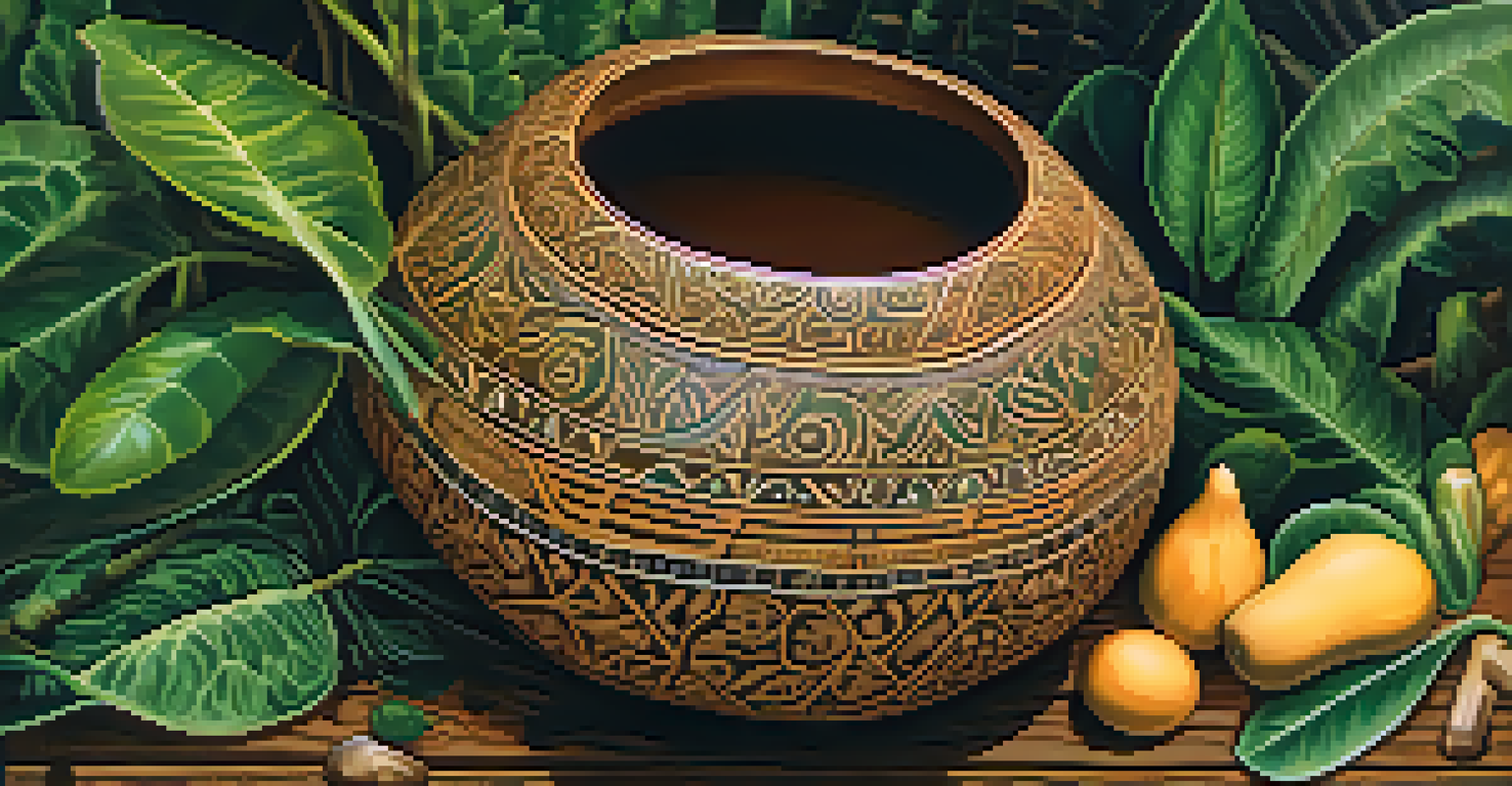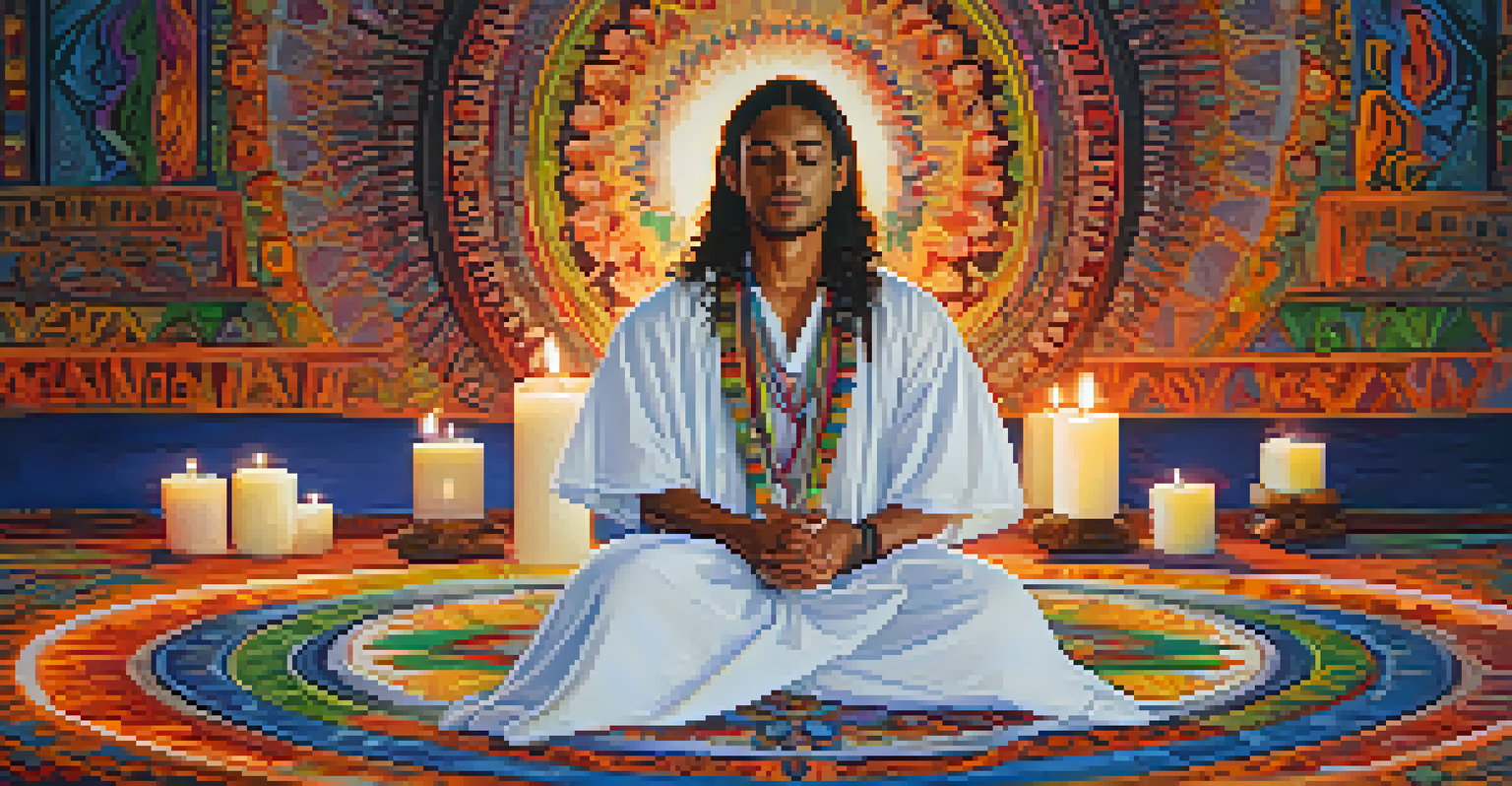Cultural Perspectives on Intent in Ayahuasca Traditions

Understanding Ayahuasca: A Cultural Overview
Ayahuasca is more than just a hallucinogenic brew; it's a profound cultural phenomenon. Traditionally used by indigenous peoples in the Amazon, it serves as a spiritual tool to connect with the divine and nature. The deep-rooted practices surrounding ayahuasca ceremonies highlight the importance of community, healing, and intentionality in its use.
The journey of self-discovery is often more profound when shared with others, as healing is not just an individual pursuit but a collective journey.
In these cultures, ayahuasca is often regarded as a teacher, guiding individuals through their spiritual journeys. Participants typically undergo a preparation process that includes setting intentions, which are crucial for the experience. This cultural context shapes how the brew is perceived and utilized, making it a unique lens through which to explore personal and communal healing.
As ayahuasca gains popularity in Western contexts, understanding its cultural significance becomes increasingly important. This ensures that the traditions and intentions of its native users are respected and preserved. Acknowledging these cultural perspectives allows for a more authentic engagement with ayahuasca practices.
The Role of Intention in Ayahuasca Ceremonies
Intention is a cornerstone of ayahuasca ceremonies, influencing how participants experience the brew. Before consuming ayahuasca, individuals are often encouraged to reflect on their goals and desires for the journey. This intentional focus helps to align the participant's mindset with the spiritual work they are about to undertake.

Different cultures may have varying approaches to setting intentions, but the common thread is the belief that clarity of purpose can enhance the experience. For example, some may seek healing from trauma, while others might pursue insight into personal relationships. Regardless of the specific intention, this preparatory step is vital in shaping the outcome of the ceremony.
Cultural Significance of Ayahuasca
Ayahuasca serves as a spiritual tool for indigenous peoples, emphasizing community, healing, and intentionality.
The act of setting intention transforms the ayahuasca experience from a mere psychedelic trip into a meaningful journey of self-discovery. This process allows individuals to explore their inner worlds and confront challenges with a sense of purpose. As such, intention amplifies the potential healing and transformative effects of the ayahuasca experience.
Indigenous Practices: Intent and Community
In many indigenous cultures, the use of ayahuasca is deeply intertwined with community and ancestral wisdom. Intentions are often shared within the group, fostering a collective energy that enhances the ceremonial experience. This community aspect underscores the belief that healing is not just an individual pursuit but a shared journey.
Intention is the driving force behind transformation; it shapes our experiences and guides us toward deeper understanding.
Shamans, or ayahuasceros, play a pivotal role in guiding these ceremonies, helping participants articulate their intentions and navigate the emotional landscapes that arise. Their expertise ensures that the ritual remains respectful of traditions while addressing the needs of the community. This communal approach emphasizes the interconnectedness of all participants.
By focusing on group intentions, indigenous practices highlight the importance of solidarity in healing journeys. This sense of belonging can be incredibly empowering, as participants realize they are not alone in their struggles. Ultimately, the communal aspect of ayahuasca ceremonies reinforces the idea that healing is a collective endeavor.
Western Adaptations of Ayahuasca Intentions
As ayahuasca spreads beyond its traditional roots, Western practitioners often adapt the concept of intention to fit their personal narratives. Many individuals approach ayahuasca with a desire for personal growth, self-exploration, or even recreational use. This shift can sometimes dilute the traditional significance of intention found in indigenous cultures.
Western adaptations may lead to a focus on individualism rather than the communal aspects inherent in native practices. While personal intentions can still yield profound experiences, they may lack the deeper context that community and tradition provide. This raises questions about authenticity and respect for the original practices of ayahuasca use.
Importance of Intention in Ceremonies
Setting clear intentions enhances the ayahuasca experience, transforming it into a meaningful journey of self-discovery.
Navigating these cultural differences is essential for those seeking ayahuasca experiences in Western settings. By honoring the original contexts and emphasizing the importance of intention, participants can create a more meaningful and respectful engagement with the brew. This mindful approach can bridge the gap between cultures while still benefiting from the transformative powers of ayahuasca.
Intent and Integration: Moving Beyond the Ceremony
Setting intention during an ayahuasca ceremony is just the beginning; integration is where true growth occurs. After the experience, participants are encouraged to reflect on their insights and how they can apply them to everyday life. This process of integration is essential for translating the revelations gained during the ceremony into actionable change.
Different cultures approach integration in varying ways, often relying on community support and guidance from shamans. In indigenous practices, storytelling and sharing experiences are integral to this process, reinforcing the lessons learned during the ceremony. This communal reinforcement can help individuals feel more grounded in their experiences.
In contrast, Western participants may seek individual therapy or support groups to help with integration. While effective, this approach can sometimes overlook the communal aspect that enhances healing. Emphasizing both personal and community integration can lead to more holistic healing experiences that respect the roots of ayahuasca traditions.
Challenges of Appropriation in Ayahuasca Practices
The growing popularity of ayahuasca in Western contexts raises concerns about cultural appropriation. Many practitioners may engage with ayahuasca without fully understanding or respecting its cultural significance. This lack of awareness can lead to a superficial engagement that strips the practice of its depth and meaning.
Cultural appropriation often manifests as a commodification of traditional practices, where the spiritual essence is overlooked in favor of personal gain. This can result in a dilution of the rich traditions surrounding ayahuasca use, ultimately impacting the indigenous communities that have preserved these practices for centuries. Respecting the cultural origins of ayahuasca is crucial to ensuring its integrity.
Challenges of Cultural Appropriation
The rise of ayahuasca in Western contexts raises concerns about cultural appropriation and the need to respect its origins.
Addressing these challenges involves fostering greater awareness and education around ayahuasca's cultural significance. By promoting respectful engagement and understanding of the traditions, individuals can cultivate a more authentic relationship with ayahuasca. This approach not only honors the original cultures but also enriches the experiences of those seeking healing and insight.
The Future of Ayahuasca and Intent in a Global Context
As ayahuasca continues to gain global recognition, the importance of understanding intent in various cultural contexts becomes increasingly vital. The future of ayahuasca practices hinges on how participants honor the traditions while adapting to their own needs. Striking this balance will be key to maintaining the integrity of ayahuasca ceremonies.
Emerging discussions around ethical practices and cultural sensitivity will likely shape the future landscape of ayahuasca use. By emphasizing education and awareness, participants can better appreciate the rich tapestry of beliefs and intentions that inform these ceremonies. This commitment to understanding will help create a more respectful and meaningful engagement with ayahuasca.

Ultimately, the future of ayahuasca and its relationship with intent will depend on the willingness of individuals to learn from and respect its diverse cultural origins. By fostering a dialogue between cultures, we can ensure that the transformative potential of ayahuasca is preserved and celebrated for generations to come.